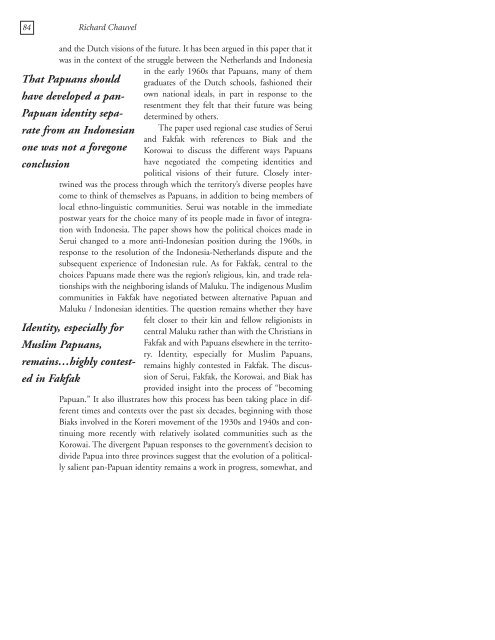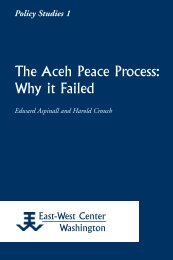Constructing Papuan Nationalism: History, Ethnicity ... - ScholarSpace
Constructing Papuan Nationalism: History, Ethnicity ... - ScholarSpace
Constructing Papuan Nationalism: History, Ethnicity ... - ScholarSpace
- No tags were found...
You also want an ePaper? Increase the reach of your titles
YUMPU automatically turns print PDFs into web optimized ePapers that Google loves.
84 Richard Chauveland the Dutch visions of the future. It has been argued in this paper that itwas in the context of the struggle between the Netherlands and Indonesiain the early 1960s that <strong>Papuan</strong>s, many of themgraduates of the Dutch schools, fashioned theirown national ideals, in part in response to theresentment they felt that their future was beingdetermined by others.The paper used regional case studies of Seruiand Fakfak with references to Biak and theKorowai to discuss the different ways <strong>Papuan</strong>shave negotiated the competing identities andpolitical visions of their future. Closely intertwinedwas the process through which the territory’s diverse peoples havecome to think of themselves as <strong>Papuan</strong>s, in addition to being members oflocal ethno-linguistic communities. Serui was notable in the immediatepostwar years for the choice many of its people made in favor of integrationwith Indonesia. The paper shows how the political choices made inSerui changed to a more anti-Indonesian position during the 1960s, inresponse to the resolution of the Indonesia-Netherlands dispute and thesubsequent experience of Indonesian rule. As for Fakfak, central to thechoices <strong>Papuan</strong>s made there was the region’s religious, kin, and trade relationshipswith the neighboring islands of Maluku. The indigenous Muslimcommunities in Fakfak have negotiated between alternative <strong>Papuan</strong> andMaluku / Indonesian identities. The question remains whether they havefelt closer to their kin and fellow religionists incentral Maluku rather than with the Christians inFakfak and with <strong>Papuan</strong>s elsewhere in the territory.Identity, especially for Muslim <strong>Papuan</strong>s,remains highly contested in Fakfak. The discussionof Serui, Fakfak, the Korowai, and Biak hasprovided insight into the process of “becoming<strong>Papuan</strong>.” It also illustrates how this process has been taking place in differenttimes and contexts over the past six decades, beginning with thoseBiaks involved in the Koreri movement of the 1930s and 1940s and continuingmore recently with relatively isolated communities such as theKorowai. The divergent <strong>Papuan</strong> responses to the government’s decision todivide Papua into three provinces suggest that the evolution of a politicallysalient pan-<strong>Papuan</strong> identity remains a work in progress, somewhat, andThat <strong>Papuan</strong>s shouldhave developed a pan-<strong>Papuan</strong> identity separatefrom an Indonesianone was not a foregoneconclusionIdentity, especially forMuslim <strong>Papuan</strong>s,remains…highly contestedin Fakfak
















